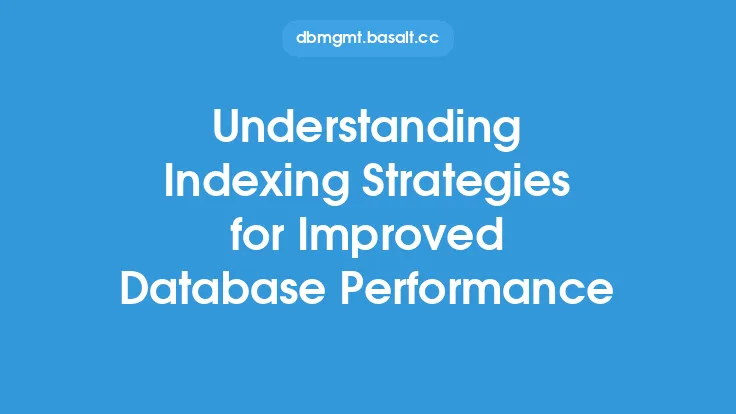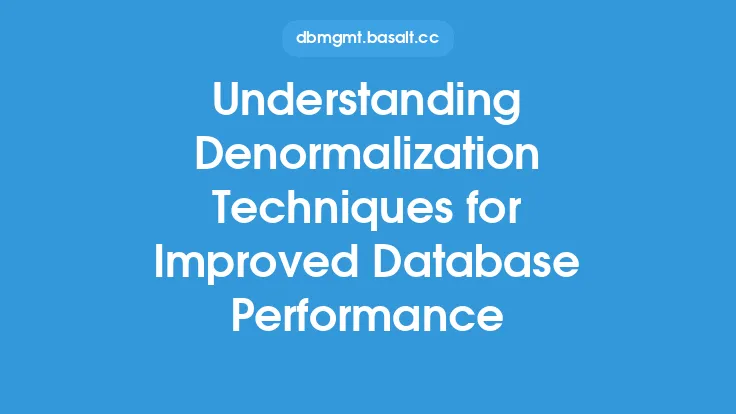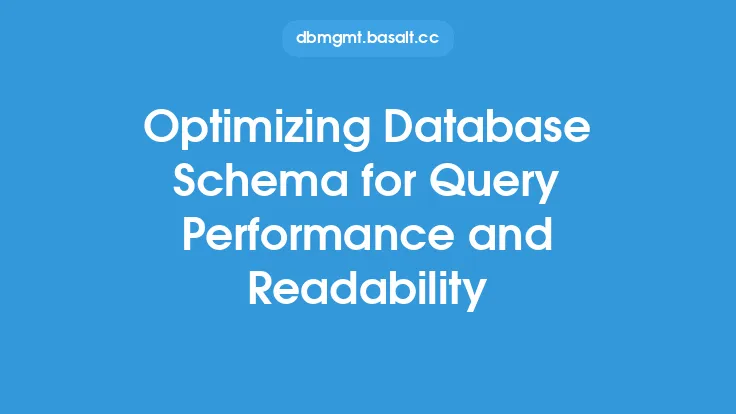Query optimization is a crucial aspect of database performance optimization, as it directly impacts the efficiency and speed of data retrieval and manipulation. At its core, query optimization involves analyzing and improving the performance of database queries to minimize execution time, reduce resource utilization, and maximize throughput. In this article, we will delve into the world of query optimization techniques, exploring the various methods and strategies used to improve database performance.
Introduction to Query Optimization Techniques
Query optimization techniques can be broadly categorized into two main types: logical optimization and physical optimization. Logical optimization focuses on rewriting the query to reduce the number of operations required, while physical optimization involves selecting the most efficient execution plan for the query. Both types of optimization are essential for achieving optimal database performance. Logical optimization techniques include query rewriting, predicate pushdown, and join reordering, while physical optimization techniques involve selecting the optimal access method, join order, and aggregation strategy.
Understanding Query Execution Plans
A query execution plan is a detailed outline of the steps required to execute a query. It is generated by the database optimizer and takes into account various factors, such as the query syntax, data distribution, and system resources. Understanding query execution plans is critical for query optimization, as it allows developers to identify performance bottlenecks and optimize the query accordingly. A typical query execution plan consists of several components, including the parse tree, optimization plan, and execution plan. The parse tree represents the syntactic structure of the query, while the optimization plan outlines the logical optimization techniques applied to the query. The execution plan, on the other hand, details the physical operations required to execute the query.
Indexing and Statistics
Indexing and statistics are two essential components of query optimization. Indexing involves creating data structures that facilitate fast data retrieval, while statistics provide the database optimizer with information about data distribution and density. Proper indexing can significantly improve query performance, as it allows the database to quickly locate and retrieve the required data. Similarly, accurate statistics are crucial for the database optimizer to generate an optimal execution plan. There are several types of indexes, including B-tree indexes, hash indexes, and bitmap indexes, each with its own strengths and weaknesses. Statistics, on the other hand, can be collected using various methods, including sampling and histogram analysis.
Join Optimization Techniques
Join optimization is a critical aspect of query optimization, as joins can be computationally expensive and impact performance. There are several join optimization techniques, including nested loop joins, merge joins, and hash joins. Nested loop joins involve iterating over each row of one table and joining it with the corresponding rows of another table. Merge joins, on the other hand, involve sorting and merging the rows of two tables. Hash joins involve partitioning the rows of one table into a hash table and then joining it with the corresponding rows of another table. The choice of join technique depends on various factors, including the size of the tables, the join condition, and the available system resources.
Subquery Optimization Techniques
Subqueries can be a significant performance bottleneck, as they involve executing a separate query for each row of the outer query. There are several subquery optimization techniques, including subquery rewriting, subquery caching, and subquery flattening. Subquery rewriting involves rewriting the subquery as a join, while subquery caching involves storing the results of the subquery in a cache. Subquery flattening involves merging the subquery with the outer query, eliminating the need for a separate subquery execution. The choice of subquery optimization technique depends on various factors, including the complexity of the subquery, the size of the tables, and the available system resources.
Query Optimization and Database Design
Query optimization is closely tied to database design, as a well-designed database can significantly improve query performance. A well-designed database should have a clear and consistent schema, with properly normalized tables and indexes. Normalization involves organizing the data into tables to minimize data redundancy and improve data integrity. Indexing involves creating data structures that facilitate fast data retrieval. A well-designed database should also have a robust data distribution strategy, with data properly partitioned and distributed across multiple nodes. This can improve query performance by reducing the amount of data that needs to be transferred and processed.
Advanced Query Optimization Techniques
There are several advanced query optimization techniques, including query parallelization, query pipelining, and query caching. Query parallelization involves executing multiple queries in parallel, improving overall system throughput. Query pipelining involves executing a series of queries in a pipeline fashion, improving query performance by reducing the overhead of query execution. Query caching involves storing the results of frequently executed queries in a cache, improving query performance by eliminating the need for repeated query execution. These techniques can significantly improve query performance, but require careful planning and implementation to ensure optimal results.
Conclusion
Query optimization is a critical aspect of database performance optimization, as it directly impacts the efficiency and speed of data retrieval and manipulation. By understanding query optimization techniques, developers can improve database performance, reduce resource utilization, and maximize throughput. This article has explored various query optimization techniques, including logical optimization, physical optimization, indexing, statistics, join optimization, subquery optimization, and database design. By applying these techniques, developers can create high-performance databases that meet the needs of their applications and users.





